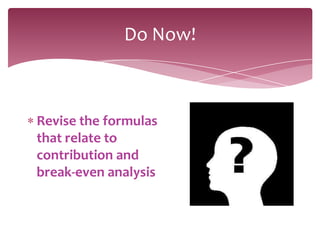1.12 break-even (part 2) - moodle
•Transferir como PPTX, PDF•
0 gostou•1,422 visualizações
AS Business
Denunciar
Compartilhar
Denunciar
Compartilhar

Recomendados
Recomendados
Mais conteúdo relacionado
Mais procurados
Mais procurados (19)
Fundamental Concepts in Decision Making – Managerial Economics

Fundamental Concepts in Decision Making – Managerial Economics
Semelhante a 1.12 break-even (part 2) - moodle
Semelhante a 1.12 break-even (part 2) - moodle (20)
1.11 calculating costs, revenue and profits - moodle

1.11 calculating costs, revenue and profits - moodle
Please review the Boston Consultant MatrixGrid. The grid is a.docx

Please review the Boston Consultant MatrixGrid. The grid is a.docx
Mais de MissHowardHA
Mais de MissHowardHA (20)
Session 7 conducting start-up market research - moodle

Session 7 conducting start-up market research - moodle
1.3 transforming resources into goods and services - moodle

1.3 transforming resources into goods and services - moodle
1.3 transforming resources into goods and services - moodle

1.3 transforming resources into goods and services - moodle
1.2 generating and protecting business ideas - moodle

1.2 generating and protecting business ideas - moodle
1.1 enterprise and entrepreneurs and the uk economy (part 2) - moodle

1.1 enterprise and entrepreneurs and the uk economy (part 2) - moodle
3.16 understanding hr objectives and strategies - moodle

3.16 understanding hr objectives and strategies - moodle
3.15 oprational strategies - lean production - moodle

3.15 oprational strategies - lean production - moodle
1.12 break-even (part 2) - moodle
- 1. Do Now! Revise the formulas that relate to contribution and break-even analysis
- 2. Do Now What is the formula used to calculate contribution? Contribution = selling price - variable cost
- 3. Do Now What is the formula used to calculate total contribution? Total contribution = unit contribution x no. of units sold
- 4. Do Now What is the formula used to calculate profit? Profit = Total contribution – fixed costs
- 5. Do Now What is the formula used to calculate break-even level of output? Break-even output = Fixed costs Contribution per unit
- 6. DO NOW Calculate this example: A firm selling birthday cakes has total fixed costs of £15,000. The variable cost of each cake is £5 and the selling price is £15. What is the break-even level of output? Clue: You should calculate contribution per unit first
- 7. DO NOW Answers: Contribution per unit: £15 - £5 = £10 Break-even level of output: £15,000 = 1500 cakes £10
- 9. Learning Objectives By the end of this lesson you should be able to: 1. Construct break-even charts. 2. Show the effects of changing costs and prices on contribution per unit, break-even charts and the break-even level of output 3. Use these concepts to assist an entrepreneur in deciding whether to start a new business or not 4. Evaluate the strengths and weaknesses of break-even analysis
- 10. Strengths and weaknesses of break-even analysis Half 1 Half 2 Produce a list of 5 Produce a list of 5 strengths of break-even weaknesses of break- analysis even analysis Reduce this to your top 2 Reduce this to your top 2 LO4 Evaluate the strengths and weaknesses of break-even analysis
- 11. Strengths and weaknesses of break-even analysis Strengths Weaknesses 1. Simple and easy to 1. Assumes all output is sold understand by most 2. Firms may sell more than entrepreneurs one product 2. Vital for decision making 3. Assumes steady and 3. Support loan applications consistent costs 4. Adapted to changing 4. Not definite – planning aid circumstances LO4 Evaluate the strengths and weaknesses of break-even analysis
- 12. Learning Objectives You should now be able to: 1. Construct break-even charts. 2. Show the effects of changing costs and prices on contribution per unit, break-even charts and the break-even level of output 3. Use these concepts to assist an entrepreneur in deciding whether to start a new business or not 4. Evaluate the strengths and weaknesses of break-even analysis